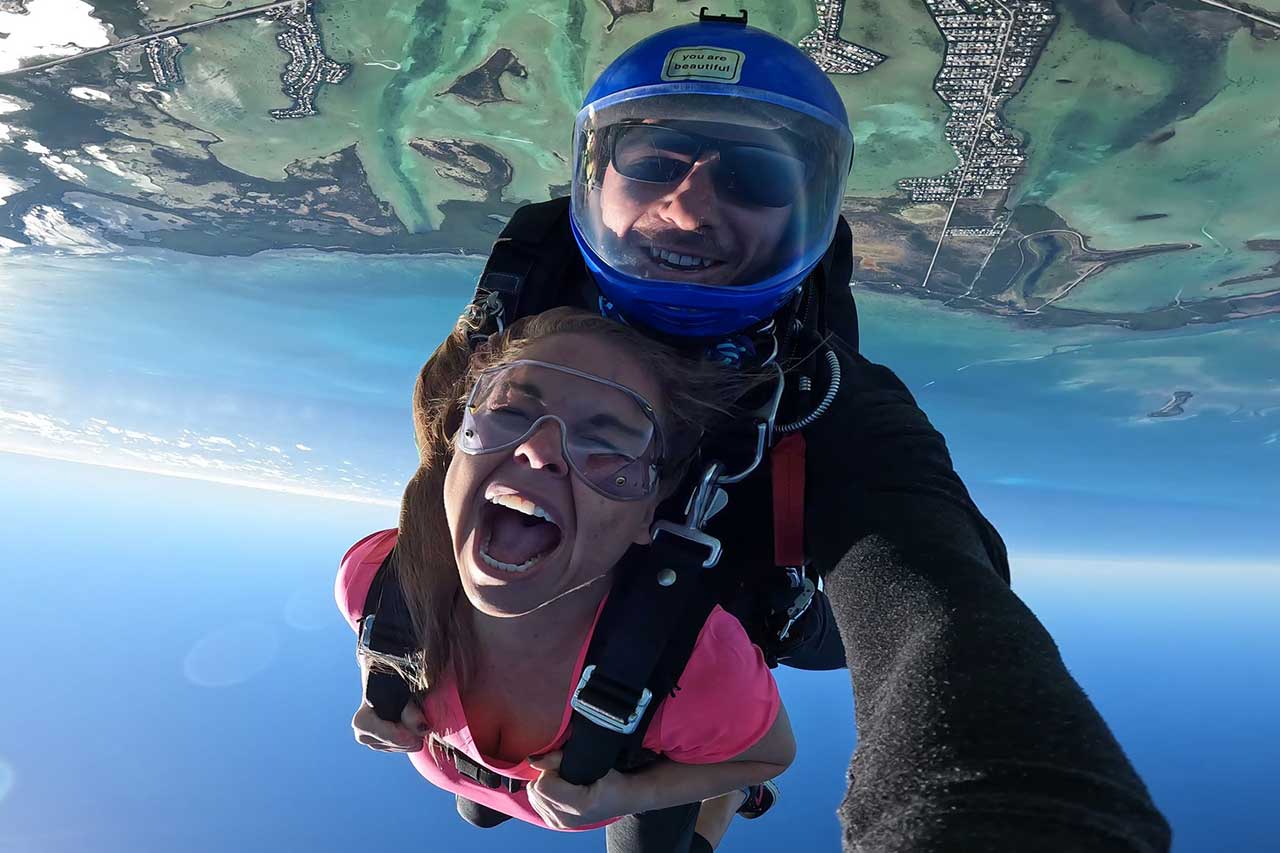Can You Skydive With Glasses or Contacts?
Skydiving
Posted by: Skydive Key West
6 months ago
Can you wear glasses while skydiving? Yep – absolutely! Skydiving with contact lenses or glasses isn’t only possible, it’s pretty common. Whether you wear glasses or contact lenses for daily vision correction, you can jump without compromising your experience.
Skydiving aims to be an accommodating and all-inclusive sport while keeping safety as #1, of course. This article will dive into how parachute goggles work, why we sometimes see photos with no goggles, and how some helmets don’t require goggles.

Skydiver Goggles: Different Than Regular Goggles?
Let’s throw it back to chemistry in high school for a second. Remember those goggles you had to wear during an experiment or lab? You may not have noticed it at the time, but they were equipped with little vents. These goggles had itty-bitty slats on the sides to allow for some ventilation – skydiving goggles work the same way!
Jumping from a plane is an adrenaline-inducing activity, and if a few beads of sweat don’t roll down your noggin’, we’d be concerned. With this extra perspiration comes the possibility of condensation. The tiny holes on the sides of the goggles are strategically placed to prevent them from fogging up and stop the air from sneaking into your lookers.
How Do You Skydive With Glasses?
Skydivers who wear glasses can skydive the same as their 20/20 vision friends!
Skydivers in spectacles have to cover them with goggles, they can’t just rock their specs solo-style. How? Are all skydiving goggles one size fits all? Not exactly, but they are pretty versatile. Those who don the ol’ squint fixers get goggles that are ever-so-slightly roomier than traditional goggles, allowing glasses to fit comfortably underneath them.
Can I Wear Contact Lenses For Skydiving?
Skydiving with corrective contact lenses is possible. Have you ever opened your contact-filled eyes underwater and lost one of them to the waves? Well … it’s a good thing there’s no water in skydiving – hah! On the other hand, we do have some pretty fast-moving air. In freefall, we soar at terminal velocity – right around 120mph. Now, even if we kept our eyes squeezed shut super tight, the air could still sneak in and pop one of our lenses right out. That’s where goggles come into play! Plus – goggles allow you to soak in the beauty below, no shut eyes allowed!
Your tandem instructor may ask you, “Do you wear contacts?” The reason for this question isn’t to prevent you from jumping but to take extra care when you do jump. Whereas everyone wears goggles in freefall, many skydivers and tandem students opt to hang their goggles around their necks while they’re under the parachute. This is not recommended for those who wear contacts or glasses, because the wind is still relatively fast under the parachute – about 15mph.
Can You Skydive Without Eye Protection?
Eeeek! You can do anything once, right? Skydiving without eye protection is not recommended for anyone – even experienced jumpers. Why? Eyeballs that have thousands of skydives and eyeballs that one skydive will react to the speed of the wind just the same – with pain.
Before every jump, skydivers give and receive gear checks. These checks are done by fellow skydivers and the jumpers themselves – we check our gear and then have one or two (or 10!) other people put their eyes on it, as well. During a gear check, skydivers make sure everything on the skydiving rig has been properly pre-flighted, and that the jumper has all appropriate gear – helmet, altimeter, tied shoes, gloves (if desired), and EYE PROTECTION. This prevents skydivers from accidentally taking the leap without anything to protect their peepers.

Are Skydiving Glasses A Thing?
Sure! There are special goggles made for skydivers, but regular glasses? Mmm, not so much. Glasses have arms that settle behind our ears, and they aren’t nearly strong enough to withstand the rush of the wind. Goggles are equipped with a stretchy strap that allows us to tighten goggles to fit each one of our unique faces. Wearing goggles flush against your face is critical to ensure wind can’t slip through the cracks.
Can Tandem Students Wear Helmets With Face Shields?
Helmets with face shields – called full-face helmets – are not permitted to be worn by tandem students. How come? We don’t want our instructors to get a bloody nose, or worse, to be head-butted in freefall – yikes! Experienced jumpers may opt for full-face helmets, and these are used in place of goggles.
Wearing goggles to protect glasses or contact lenses during any portion of the skydive won’t prohibit it from being the best and most memorable time of your life – it’ll enhance it! We can’t wait to skydive with you – book your jump today. Blue skies!




